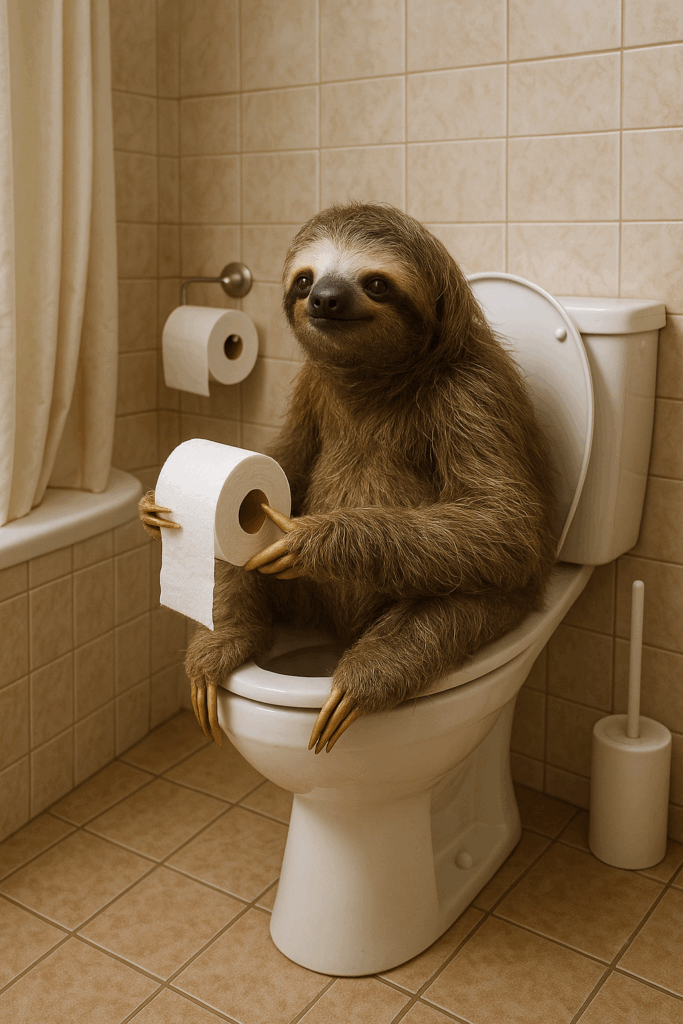Let me tell you about one of evolution’s strangest decisions.

Imagine if every time you needed to use the bathroom, you had to: wait an entire week, risk death to do it, and lose nearly a third of your body weight in the process. You’d probably call that a design flaw. But for sloths? That’s just Tuesday.
The Weekly Ordeal
Sloths poop once a week. Once. A. Week.
While you and I are making multiple trips to the bathroom daily like it’s no big deal, sloths are up in the canopy, holding it in like they’re on the world’s longest road trip with no rest stops. For seven whole days, they’re just… waiting. Hanging around. Literally.
But here’s where it gets truly bizarre: when nature finally calls, they don’t just go wherever they happen to be. Oh no. That would be too easy, too sensible, too not-sloth.
The Death-Defying Descent
Instead, these creatures who move so slowly that algae grows on their fur, make the agonizing decision to climb down from their safe treetop homes. All the way down. To the forest floor.
Let me put this in perspective: sloths are basically Olympic champions at hanging in trees. They eat in trees. They sleep in trees. They mate in trees. They give birth in trees. Trees are their whole thing. They’re so adapted to arboreal life that they can barely walk on the ground without looking like a drunk person trying to navigate a bouncy castle.
So why on earth would they descend to the most dangerous place in their world where jaguars, ocelots, and harpy eagles are all too happy to turn them into a slow-moving snack just to poop?
Scientists have been scratching their heads about this for years.
The 30% Solution
And it gets weirder. When a sloth finally does its business, it loses up to 30% of its body weight. Thirty percent.
To put that in human terms: imagine if you weighed 150 pounds and every bathroom trip cost you 45 pounds. You’d emerge from the bathroom looking like you’d just completed an extreme weight loss program. You’d need a whole new wardrobe. Your friends would stage an intervention.
For sloths, this weekly purge is so significant that they actually have a special “poop dance” they do: a wiggling motion that helps them go. It’s both adorable and deeply concerning.
Why Do They Do This?
Here’s where the story gets even more interesting. For years, this behavior seemed like evolutionary nonsense. Why would an animal risk its life for a bathroom break it could safely take from the trees?
Recent research suggests a few theories. The most compelling one involves the sloth’s unusual relationship with moths. Yes, moths. Certain species of moths live in sloth fur, and they need sloth poop to complete their life cycle.
When a sloth descends to poop, female moths lay eggs in the fresh dung. The moth larvae feed on it, mature, then fly up to find a new sloth host.
In return, these moths may help fertilize the algae that grows in sloth fur, and sloths actually eat this algae as a nutritional supplement. It’s like having a garden on your back, but the gardeners are moths, and you have to risk death weekly to keep the system running.
The Slow Life Tax
There’s another theory, too: by pooping at the base of their favorite trees, sloths might be fertilizing their own food source. It’s the ultimate closed-loop system if you ignore the whole “might get eaten by a jaguar” part.
But perhaps the most humbling explanation is simply that sloths are so slow and have such low-energy lifestyles that they’ve evolved this once-a-week schedule out of pure metabolic necessity.
Their digestive systems are so sluggish that it literally takes a week to process their leafy diet. They’re not being strategic; they’re just that slow at everything, including digestion.
Evolution has given us many wonders: the eagle’s vision, the cheetah’s speed, the dolphin’s intelligence. And then there’s the sloth’s bathroom routine, which is basically a weekly heist movie where the stakes are life and death, and the prize is… well, you know.
Nature is beautiful. Nature is mysterious. And sometimes, nature is absolutely ridiculous.
Bowerbirds Sabotage Rivals’ Mating Displays: Nature Facts
Nature’s Best Actor: The Killdeer Bird That Fakes Death to Fool Predators






